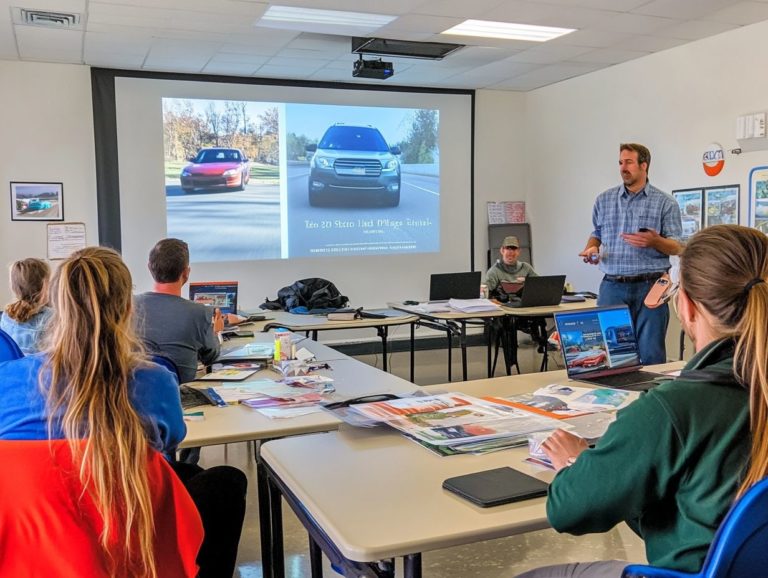Tips for Young High-Risk Drivers Seeking Insurance
Navigating the world of auto insurance can feel daunting, especially for high-risk drivers like you. Whether it s your age or a less-than-perfect driving record, understanding your unique situation is vital.
This article explores what categorizes high-risk drivers, the factors contributing to this designation, and the insurance options available to you. It also offers practical tips for reducing your premiums and successfully navigating the insurance process, along with valuable resources for further support.
Jump in now to discover the best strategies for saving on your insurance!
Contents
- Key Takeaways:
- Understanding High-Risk Drivers
- Factors that Contribute to High-Risk Status
- Insurance Options for High-Risk Drivers
- Tips for Lowering Insurance Premiums
- Navigating the Insurance Process as a High-Risk Driver
- Resources for High-Risk Drivers
- Frequently Asked Questions
- What is considered a high-risk driver?
- What are some tips for young high-risk drivers seeking insurance?
- Why do young high-risk drivers typically have higher insurance rates?
- Is it possible for young high-risk drivers to lower their insurance rates?
- Can I still get insurance if I am considered a high-risk driver?
- What should I do if I can’t afford the high insurance rates for young high-risk drivers?
Key Takeaways:

- Understand what it means to be a high-risk driver and how it affects your insurance premiums.
- Factors such as age and driving record can contribute to your high-risk status, but there are proactive measures you can take to lower your insurance costs.
- Be aware of the steps to take when seeking insurance as a high-risk driver and utilize available resources and programs for assistance.
Understanding High-Risk Drivers
Knowing whether you are a high-risk driver is vital for saving money on insurance! High-risk drivers are typically identified based on various factors that suggest a higher likelihood of filing claims or being involved in accidents.
Your classification as a high-risk driver affects your insurance premiums significantly. By exploring the traits and behaviors linked to high-risk driving like a history of DUI convictions, traffic violations, or multiple accidents you gain valuable insight into the details of car insurance and the financial responsibilities that come with driving.
Defining High-Risk Drivers
A high-risk driver is generally someone whose driving record shows behaviors or incidents that increase the chances of being involved in accidents. This classification can lead to higher insurance premiums.
Several factors contribute to this classification. A series of traffic violations can indicate reckless behavior, while DUI convictions signal a serious disregard for safe driving. A history of multiple accidents suggests a troubling pattern of irresponsible driving.
Each of these factors impacts your driving history and plays a crucial role in determining your insurance rates. Insurers carefully review such records to assess risk levels, resulting in premiums that can be significantly higher due to these concerning patterns.
Factors that Contribute to High-Risk Status
Several elements contribute to your high-risk status when it comes to car insurance. Thus, providers must assess these factors with precision.
Key risk factors include your driving record, any traffic violations, and the number of DUI convictions. If you’re a young driver, you often face high-risk classification due to your inexperience, which typically results in higher insurance premiums.
A poor credit history can also raise your insurance costs and limit your coverage options.
Age, Driving Record, and Other Considerations
Age and driving record are crucial elements in determining your status as a high-risk driver, especially if you are young. Statistically, younger individuals are more prone to traffic violations and accidents.
This trend often leads to higher insurance premiums, as insurers evaluate the likelihood of claims. Conversely, older drivers, who usually have more experience and a solid track record of safe driving, may enjoy more favorable rates.
Your safe driving habits significantly impact your insurance costs. Maintaining a clean record, free from accidents and tickets, can greatly enhance your insurability. Additionally, factors like the type of vehicle you drive, your location, and even the time of year can influence insurance pricing, showcasing the complex nature of this vital financial consideration.
Insurance Options for High-Risk Drivers

High-risk drivers like you have various insurance choices available. However, be prepared for higher premium costs compared to standard drivers due to perceived increased risk.
Explore specialized high-risk insurance policies that cater to your specific needs. Compare auto insurance quotes from multiple providers to find the best fit for your situation.
This not only helps meet state insurance requirements but also helps manage your finances effectively.
Types of Insurance Available
High-risk drivers can choose from several insurance options. This includes minimum coverage choices, specialized high-risk policies, and usage-based insurance that rewards safe drivers.
Consider liability coverage for protection against damages to others in an accident. This becomes crucial if you have a history of incidents.
Some insurers offer usage-based insurance programs that track your driving habits and might help you lower your premiums over time. By improving your driving behavior, you can enjoy better rates in the future.
Tips for Lowering Insurance Premiums
Lowering your insurance premiums is a common goal for high-risk drivers. You can take proactive steps to achieve this.
Take a defensive driving course to enhance your skills and potentially earn discounts. Don’t forget to shop around for the best insurance quotes that fit your budget.
These actions can significantly reduce your premiums.
Proactive Measures to Reduce Risk and Cost
Adopting proactive measures to reduce both risk and insurance costs is crucial for high-risk drivers. By maintaining a clean driving record and engaging in safe driving habits, you can make a significant difference.
Consistently follow traffic laws and regulations. This contributes to your safety and helps build a positive driving history that insurers appreciate. Consider enrolling in defensive driving courses to enhance your skills and potentially earn discounts.
Keeping an eye on road conditions and avoiding distractions, such as using a mobile device while driving, is essential for a safer journey. Regularly review your insurance policies to understand coverage options that promote responsible driving, fostering a culture of safety and accountability.
Navigating the insurance process as a high-risk driver may seem daunting, but knowing what to do if you’re classified as a high-risk driver can help you gather insurance quotes and work with agents to streamline your experience.
As a high-risk individual, actively seek quotes from various providers to secure the most competitive premium rates. Being transparent about your claims history and existing policies allows agents to offer customized insurance solutions that align with your needs and financial responsibilities.
Steps to Take When Seeking Insurance

If you’re a high-risk driver seeking insurance, follow specific steps to meet necessary requirements. Gather documentation such as an SR-22 a form that proves you have car insurance or an FR-44, which may have stricter requirements if mandated by your state.
Start by collecting essential paperwork. This might include proof of your previous insurance, a valid driver s license, and any relevant traffic violation records. Once your documentation is in order, check the specific requirements outlined by various insurance providers, as these can vary widely.
Evaluate the financial strength ratings of potential insurers. This rating shows how well they can pay claims. Seek feedback from current or past policyholders to gain valuable insights, helping you make informed decisions and select an insurance plan tailored to your needs.
Resources for High-Risk Drivers
High-risk drivers can tap into a wealth of valuable resources and organizations offering tailored programs designed to meet their unique insurance needs. These programs can enhance their financial responsibility and provide essential support in navigating their situation.
Organizations and Programs for Assistance
Numerous organizations and programs support high-risk drivers. They offer invaluable insurance resources and community support aimed at fostering financial responsibility.
For example, the Federal Insurance Administration’s High-Risk Pool is vital for drivers who urgently need coverage. Additionally, initiatives like California’s Low-Cost Auto Insurance Program focus on providing affordable options for lower-income high-risk drivers.
Nonprofit organizations like the National Safety Council play a crucial role in this landscape. They offer educational resources and workshops that enhance driving habits, potentially leading to better insurance rates for individuals previously categorized as high-risk.
Frequently Asked Questions
What is considered a high-risk driver?
A high-risk driver is someone more likely to have accidents, often due to their driving history or age. This can include new drivers, those with multiple traffic violations or accidents, or individuals with high-performance vehicles.
What are some tips for young high-risk drivers seeking insurance?

- Shop around for quotes from multiple insurance companies to find the best deal.
- Consider taking a defensive driving course to improve your skills and potentially lower your insurance premiums.
- Choose a higher deductible to reduce monthly payments, but ensure you have enough savings for an accident.
- Look for discounts like good student discounts or safe driving rewards.
- Be honest about your driving history when applying for insurance to avoid issues later.
- Consider adding a parent or guardian as a co-signer on your policy to potentially lower your rates.
Why do young high-risk drivers typically have higher insurance rates?
Insurance companies view young drivers as inexperienced and therefore more likely to be involved in accidents. High-risk drivers with previous violations are also seen as a higher liability for insurers.
Is it possible for young high-risk drivers to lower their insurance rates?
Yes, young high-risk drivers can lower their rates by taking a defensive driving course, maintaining a clean driving record, and choosing a safe and practical vehicle.
Have you tried any of these tips? Share your experiences!
Can I still get insurance if I am considered a high-risk driver?
Yes! Most insurance companies offer coverage to high-risk drivers. However, the premiums will likely be higher than those for low-risk drivers.
It’s crucial to shop around and compare quotes. This helps you find the best option for your specific situation!
What should I do if I can’t afford the high insurance rates for young high-risk drivers?
If you struggle to afford high insurance rates, ask a parent or guardian for help. They may add you to their insurance to lower your rates.
Look into options for reducing coverage or finding discounts to lower your premiums! Improving your driving record over time can also help lower your rates in the future.






